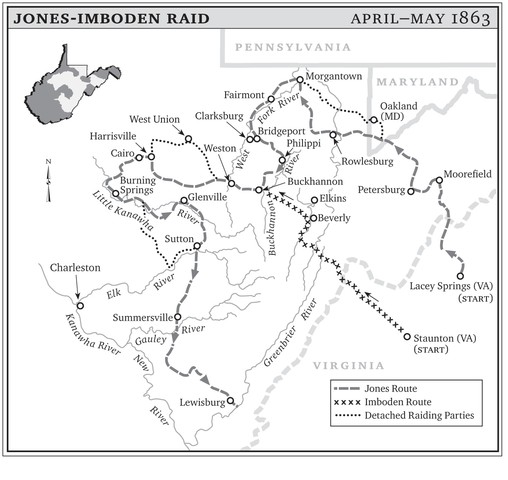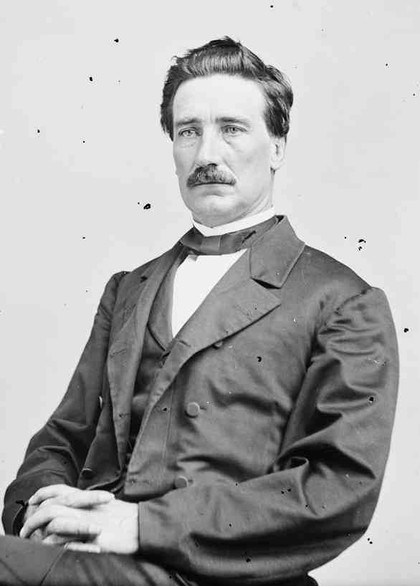Skirmish at Beverly during the Jones-Imboden Raid
Introduction
Text-to-speech Audio
Images
Drawing of the Federal camp at Beverly in 1861.

Map of the Jones-Imboden Raid's route through what is now West Virginia.

Photograph of General John D. Imboden, Confederate commander at the skirmish at Beverly.

George R. Latham, Union commander at the skirmish at Beverly.

Backstory and Context
Text-to-speech Audio
Many Confederate leaders considered retaining control of what was then western Virginia key to the success of their rebellion. Losing the region would not only leave the Shenandoah Valley from which the Army of Northern Virginia received much of its food vulnerable, it would also give Union forces a more direct route from east to west between the two main theaters of the war. As a result, Confederate troops had spent considerable time and effort attempting to secure it for their cause, most notably in the campaigns of Stonewall Jackson in 1862.
The plans for the Jones-Imboden Raid in particular, however, began as early as the winter of 1862 with Confederate leaders hoping to execute a lightning fast surprise attack against the Baltimore & Ohio Railroad bridge at Rowlesburg in Preston County. Over the course of the following spring, however, the plans expanded to envision parallel attacks through the counties that became West Virginia: the first, under General John D. Imboden, would march through Beverly before turning northward toward Oakland, Maryland; the second, under General William E. Jones, would march toward Charleston as a diversion. By late March, however, the roles had switched, Jones using his greater influence and higher rank to claim command of the main attack, which would now target Rowlesburg and Oakland while Imboden’s men attacked Beverly and Buckhannon.
Imboden set out for Beverly from Staunton, Virginia on April 20, 1863, the same day that President Abraham Lincoln gave his formal approval for West Virginia’s statehood. His men traveled on what was then the Staunton-Parkersburg Turnpike, now US 250. With some clever political wrangling, the leaders of Randolph County had convinced the Virginia Assembly to route the turnpike through the then county seat of Beverly when the road was built in the 1830s and ‘40s. As a result, the turnpike does not follow a direct route from Staunton to Parkersburg but rather fishhooks north to enter the town of Beverly before continuing westward.
Imboden followed this route over the course of three days, a 100-mile trek that took his troops through rain, sleet, and snow. On the night of April 23, he camped in Huttonsville a little over ten miles south of Beverly on the turnpike. Convinced that the Federal troops in Beverly had already learned of his arrival in the area, he sent a scouting party toward the town under Captain Joseph French Harding in order to confirm his suspicions. Instead Harding’s party encountered the Unionist sheriff of Randolph County Jesse Phares, who managed to escape to warn the unsuspecting Federals despite receiving a gunshot wound through the lung from Harding himself.
Upon receiving news of Imboden’s proximity the Federal commander at Beverly, Colonel George R. Latham, sent word to his commander General Benjamin S. Roberts at Clarksburg. Upon hearing back that he should defend the town as best as possible but withdraw his men if they were in danger of being overwhelmed, Latham arrayed the bulk of his 878 men on a plateau a mile south of town that overlooked the turnpike while keeping some on the northern edges of the town as a reserve. When Imboden saw these defenses upon nearing the town on the morning of April 24, he chose not to engage for fear of suffering catastrophic losses. He had already sent a contingent of cavalry under his brother Colonel George Imboden west across the Tygart Valley River to march north in order to cut off Latham’s retreat toward Buckhannon. Seeing Latham’s preparations, he then ordered another contingent to swing eastward and then northward to cut off any retreat by the Federals toward Philippi. While the flanking movement to the west succeeded, George Imboden’s men fighting house to house to secure the road to Buckhannon, the one to the north got lost and was unable to block Latham’s retreat when he chose to execute it after several hours of skirmishing with the Confederates to his front.
When the Confederates entered Beverly, they were immediately set to work putting out the fires Latham’s men had started in an effort to destroy the Federal supplies there. Though the Federals had only put the torch to their supply depot, the flames quickly spread to engulf a full third of the town. With the help of Beverly’s citizens, the rebel forces just as quickly doused them and managed to keep the entire town from being destroyed. Imboden remained in the town until April 26 and though initially welcomed by the majority secessionist locals soon alienated residents by requisitioning food for his perennially ill-supplied men using notoriously inflated Confederate paper currency. After two days of occupying the town, however, the general ordered his men to begin the march toward Buckhannon, where he was meant to rendezvous with General Jones and proceed to an attack against General Roberts.
Sources
Collins, Darrell L. The Jones-Imboden Raid: the Confederate Attempt to Destroy the Baltimore & Ohio Railroad and Retake West Virginia. Jefferson, NC: McFarland & Co., 2007.
“Imboden's Expedition into West Virginia.” In United States Congressional Serial Set, 2766:90–106. Washington, D.C.: United States Government Printing Office, 1891.
Maxwell, Hu. TextsThe History of Randolph County, West Virginia. From Its Earliest Settlement to the Present, Embracing Records of All the Leading Families, Reminiscences and Traditions. Morgantown: Acme Publishing Co., 1898.
Swick, Gerald D. “The West Virginia Encyclopedia.” In The West Virginia Encyclopedia. West Virginia Humanities Council, March 25, 2014. https://www.wvencyclopedia.org/articles/1059.
Tucker, Spencer. Brigadier General John D. Imboden: Confederate Commander in the Shenandoah. Lexington: University Press of Kentucky, 2003.
West Virginia and Regional History Center
The West Virginia Encyclopedia
Wikipedia
Wikipedia
